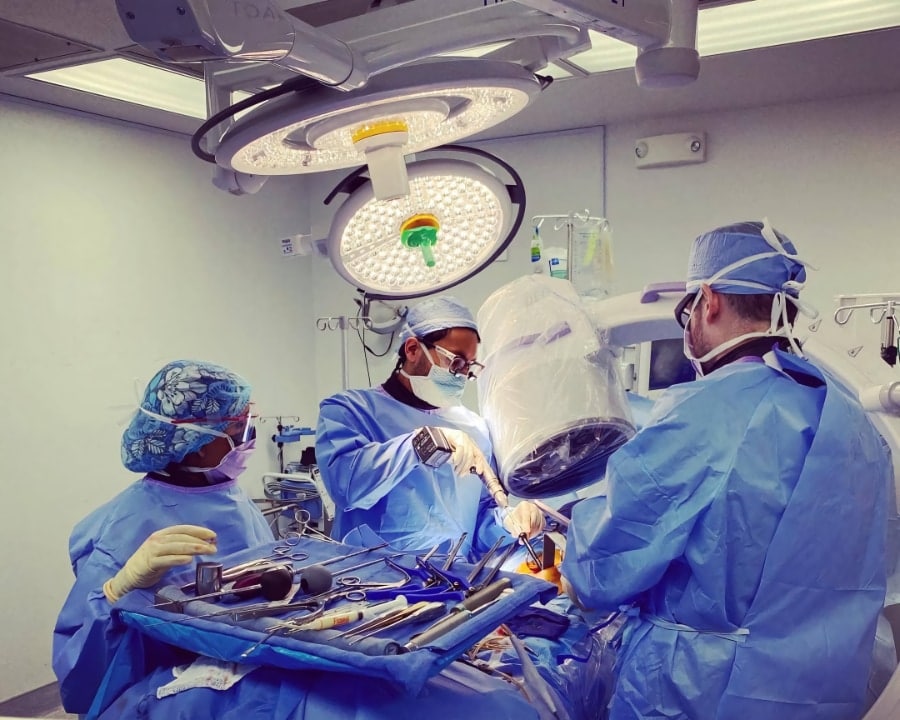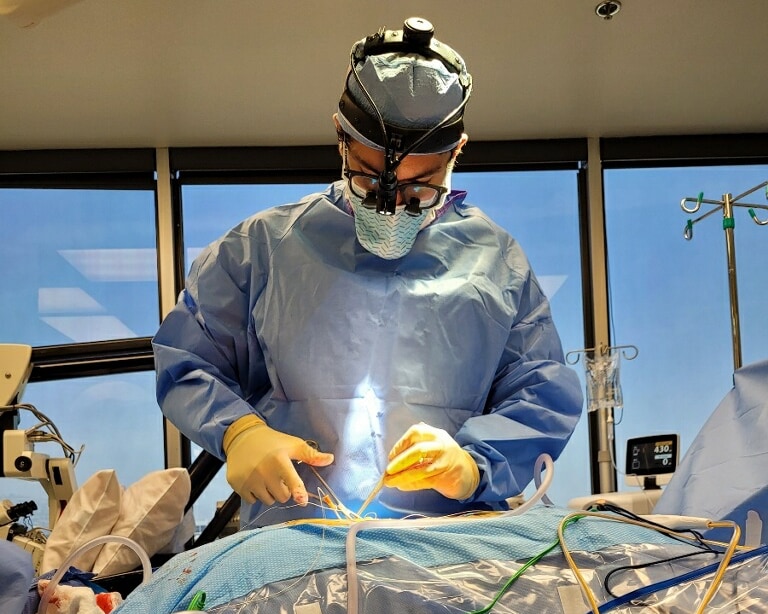Orthopedic Spine Surgeons Panorama City CA
Adult spinal conditions are frequently complex and life-changing. Dr. Alexander Ghasem and his team at LA Spine Surgeons are here to diagnose your condition and help you get back on track with your life.
About LA Spine Surgeons
We are experts in the diagnosis and treatment of a wide range of spine-related issues. Our orthopedic specialists are skilled in performing procedures and interventions to alleviate symptoms associated with spinal conditions and disorders such as neck and back pain, cervical disc herniation, cervical stenosis with myelopathy, thoracic and lumbar stenosis, sciatica, spinal tumors, spinal trauma, degenerative scoliosis, adjacent level disease, and revision surgery.
Our mission is to assist our patients in improving their ability to function and relieving their discomfort through the use of highly personalized treatment regimens.

Cervical Procedures
Cervical Artificial Disc Replacement
Artificial disc replacement is a motion sparing minimally invasive procedure performed through an anterior incision in the cervical spine.
Cervical Microforaminotomy
Cervical microforaminotomies are minimally invasive procedures done through a posterior incision in the neck for upper extremity pain and/or weakness (radiculopathy).
Cervical Posterior Decompression & Fusion
When conservative measures fail for the treatment of congenital or degenerative cervical spinal stenosis, or in the setting of tumors, infection, or trauma, a posterior approach to the cervical spine may be indicated.
Microdiscectomy
For symptoms of nerve compression including shooting leg pain and altered bowel or bladder function corresponding to a disc herniation and there is no indication for a fusion, a microdiscectomy is an effective treatment option.
Anterior Cervical Discectomy & Fusion
As the name implies, an ACDF is a minimally invasive fusion operation performed through an anterior incision in the cervical spine to relieve pressure placed on the spine. It is effective in treating degenerative disc disease (DDD), bone spurs, or disc herniations resulting in cervical myelopathy or arm pain (radiculopathy) as well as neck pain.
Cervical Disc Arthroplasty
With the advantage of performing a single posterior approach for both the disc spacer insertion and the posterior instrumentation, a TLIF is an excellent minimally invasive surgical option. The operation is indicated for patients who have vertebral slips (spondylolisthesis), severe foramina stenosis, Degenerative Disc Disease (DDD), adjacent level disease from prior spine surgery, disc space infections, and scoliosis
Lumbar Procedures
Thoracic & Lumbar Decompression
Once non-operative measures have failed for patients with stenosis, a laminectomy decompression procedure is an excellent treatment option.
Lumbar Posterior Instrumented Fusion
A lumbar posterior instrumented fusion can be performed through an open incision or percutaneously with the rods passed through the screw tabs and confirmed fluoroscopically.
Posterior Lumbar Interbody Fusion
With the advantage of performing a single posterior approach for both the disc spacer insertion and the posterior instrumentation, a TLIF is an excellent minimally invasive surgical option.
Computer Assisted Navigation & Robotics
Computer assisted navigation can be used in decompression and fusion procedures to improve accuracy through virtual spatial recognition of anatomic structures in real-time based on acquired imaging scans.
Transforaminal Interbody Fusion
With the advantage of performing a single posterior approach for both the disc spacer insertion and the posterior instrumentation, a TLIF is an excellent minimally invasive surgical option.
Anterior Lumbar Interbody Fusion
ALIF is a minimally invasive surgical procedure in which the disc and Anterior Longitudinal Ligament is excised through an anterior abdominal incision and replaced with a spacer for the purpose of fusion.
Lateral Interbody Fusion
The operation is indicated for patients who have vertebral slips, Degenerative Disc Disease (DDD), adjacent level disease from prior spine surgery, Psoas abscesses, and scoliosis and/or sagittal deformities that have failed nonoperative treatment regimens.

Meet Dr. Alex Ghasem
Dr. Alexander D. Ghasem, M.D. is a Los Angeles-based nationally renowned orthopedic spine surgeon. He is an expert in motion preservation surgery, minimally invasive procedures, degenerative disorders, and complex spinal revision surgery. When appropriate, he focuses on outpatient surgical intervention to safely return patients to their families.
Dr. Ghasem has authored numerous publications and is a recognized expert in robotic surgery and minimally invasive surgery. His research has been presented at a number of academic conferences, and he has given a number of educational lectures and podium presentations.
Frequently Asked Questions
Here are the most frequently asked questions regarding spine surgery so that you can have confidence in your treatment plan. Ready to schedule an appointment? Call us today!
- 14860 Roscoe Blvd Suite 200 Panorama City, CA 91402
- (310) 715-3237
What is the most common type of spine surgery?
This is largely based on the region of the spine and the age of the patient. While we do carry out fusions when necessary, in the lumbar spine we most commonly perform partial discectomies/decompression type surgeries with our focus being motion sparing operations in the low back. Cervical spine operations in the neck mainly consist of artificial disc replacements and Anterior Cervical Discectomy and Fusions (ACDFs).
What kind of back pain requires surgery?
Isolated back pain often times is able to be treated through nonoperative modalities. Causes of isolated back pain which may be indications for surgery after failed conservative treatment include fractures and symptomatic instability. Back pain can also be generated from nerve compression, known as lumbar stenosis. More classical presentations of nerve compression however, generate pain and sensory changes in the lower extremities. As experts, we’re able to help identify pain generators and guide you to the right treatment pathways.
How long does it take to walk after spine surgery?
This largely depends on your baseline ambulatory ability before the operation. The vast majority of our patients are walking the same day following surgery. An expeditious recovery and early mobilization is a cornerstone in our successful formula.
Is outpatient surgery an option in spine surgery at a hospital or surgery center?
Absolutely. With advances in anesthesia protocols and minimally invasive techniques, we routinely are able to perform spinal operations in an outpatient setting. With more focused nursing and direct surgeon oversight in the postoperative setting, we are able to safely get you back home on an accelerated time table. This is to make you feel more comfortable and to reduce your risk of infection.
Does spinal fusion last forever?
Once a level has healed and is fused, those vertebrae are permanently joined. They can only be separated through fracturing of that fusion through trauma or revision spinal osteotomy surgery. Attention should be paid to adjacent levels following fusion operations.
Are neck and back spinal surgery worth the risk?
In some instances, spine surgery is emergent and time is of the essence for preservation of function. However, other times spine surgery is an elective process that is a quality of life decision made by you with the guidance of your spine specialist. Our expertise is offered to allow you to make an informed decision before moving forward with your procedure.
What are signs and symptoms of nerve compression that are related to my spine?
Radiating pain, spasms, and tingling/numbness into the arms or legs can be a sign of nerve compression. Balance changes as well as hand coordination deterioration along with increased spasticity can also be indicators of spinal cord compression, referred to as myelopathy. Changes in bowel and bladder habits are potential sequelae of severe nerve compression and in combination with other findings should prompt urgent evaluation.
When is the right time to come in for a spine surgery consultation?
At any stage of your spine work up or treatment regimen, we are delighted to evaluate and care for you. Whether your condition leads to surgery or not, we are here to point you in the right direction to achieving your health goals. Our team will help gather the necessary diagnostics to build the specialty care plan best suited for you.
LA Spine Surgeons provide service to:
City service area:
Panorama City, Mission Hills, Pacoima, North Hollywood, Van Nuys, San Fernando, Sun Valley, Granada Hills, Toluca Lake, Sylmar, Reseda, Sherman Oaks, Encino, Northridge, Burbank, Studio City, Tarzana, Porter Ranch, Winnetka, Universal City, Sunland, Beverly Hills, Tujunga, Chatsworth, Woodland Hills, Canoga Park, La Crescenta, Topanga, Stevenson Ranch, La Canada Flintridge, Canyon Country, Simi Valley
Counties:
Los Angeles, Ventura, Riverside, San Bernardino
Zip codes in service area:
90027, 90039, 90046, 90049, 90068, 90069, 90077, 90210, 90272, 91011, 91020, 91040, 91201, 91202, 91203, 91204, 91205, 91206, 91207, 91208, 91214, 91303, 91304, 91306, 91307, 91311, 91316, 91321, 91324, 91325, 91326, 91330, 91331, 91335, 91340, 91342, 91343, 91344, 91345, 91352, 91356, 91364, 91367, 91371, 91401, 91402, 91403, 91405, 91406, 91411, 91423, 91436, 91501, 91502, 91504, 91505, 91506, 91601, 91602, 91604, 91605, 91606, 91607, 91608
What makes Panorama City, CA so special:
The Great Wall of Los Angeles
The Great Wall of Los Angeles Monument is one of the country’s largest interracial harmony monuments. Judy Baca, a muralist and SPARC co-founder, came up with the idea for the Great Wall. It was painted by artists, community members, and more than 400 youth between 1976 and 1983. The mural can be seen on the concrete sides of the Tujunga Wash in the San Fernando Valley.
Los Encinos State Historic Park
Los Encinos State Historic Park is graced with a natural spring whose water was formerly said to be so pure that animals traveled miles to drink from it. Due to the abundant water supply, Indians of the tribe now known as the “Gabrielino,” “Fernandeno,” or “Tongva” lived on the park’s site for hundreds, if not thousands, of years. The park is located in Encino, California, on the corner of Balboa and Ventura Boulevards.
Mission San Fernando Rey de España
On September 8, 1797, Father La Suen founded Mission San Fernando Rey de España, which bridged the divide between San Buenaventura on the coast and San Gabriel in the interior. Mission San Fernando became a popular stopping point for travelers on El Camino Real due to its location right on the highway leading to the rapidly burgeoning settlement of Los Angeles.

